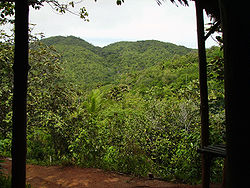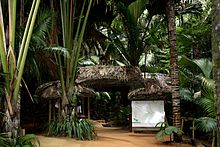Vallée de Mai
| Vallée de Mai nature reserve | |
|---|---|
|
UNESCO world heritage |
|

|
|
| View of the Vallée de Mai, lookout point |
|
| National territory: |
|
| Type: | nature |
| Criteria : | vii, viii, ix, x |
| Surface: | 20 ha |
| Reference No .: | 261 |
| UNESCO region : | Africa |
| History of enrollment | |
| Enrollment: | 1983 (session 7) |
The Vallée de Mai ( German "Maital" ) is a national park on the island of Praslin and one of the most famous sights of the Seychelles . It was added to the UNESCO World Heritage List in 1983.
history
The densely overgrown valley is one of the world's smallest national park areas with 19.5 hectares. The landscape is a remnant of a prehistoric forest that existed when the granite rocks still belonged to the continent of Gondwana . The Precambrian Seychelles granite in the valley is around 650 million years old. The millions of years of evolutionary isolation of the Seychelles allowed unique plants and animals to develop. Nowhere in the Seychelles can this be seen as clearly as in the Vallée de Mai.
The valley remained untouched until around 1930 - in contrast to most other areas of the Seychelles. Around the 1930s, a new landowner decided to redesign the valley as a recreation area and botanical garden. Ornamental plants, coffee and fruit trees were introduced to "beautify" the valley. It was not until 1945 that the valley passed from private property to government property. Since then, the government has pursued the goal of exterminating all non-local plants and returning them to their original state. This takes time because many endemic species have disappeared. The valley was declared a national park in 1966 and a UNESCO World Heritage Site in 1983. It has been administered by the Seychelles Island Foundation since 1989.
Flora and fauna
The Vallée de Mai is the traditional home of the Seychelles palm . A total of 5000 such palm trees can be found there in a very small space, which corresponds to the largest number in one place worldwide. In addition to the Seychelles palm, you can also find the five other endemic palm species of the Seychelles here, withdeckeia nobilis , Verschaffeltia splendida , Phoenicophorium borsigianum , Roscheria melanochaetes and Nephrosperma van-houtteanum . You can also find three of the four endemic screw tree species of the Seychelles: Pandanus hornei , Pandanus sixellarum and Pandanus multispicatus .
There are several specimens of the critically endangered Lesser Vasa Parrot . The chameleon Calumma tigris is endemic there. There are also various nectar birds, island blackbirds , geckos and snails in the Vallée de Mai . The only mammals are the Seychelles fruit bat and the great tenrek, which is not originally native to the Seychelles .
Leaves of the Seychelles palm
tourism
The valley is one of the most popular tourist attractions in the Seychelles. You can enter it for a price of 350 rupees (approx. 22 euros (as of 2017)). It is inland and can be reached by bus. The area is traversed by a stream that turns into a waterfall and accessed by several paved and marked paths. At the top of a hill, the Vallée de Mai can be viewed from a vantage point. It is strictly forbidden to smoke, leave anything behind in the Vallée de Mai or take anything with you from the Vallée de Mai.
literature
- Friedemann needy : 100 wonders of the world. Neumann & Göbel Verlagsgesellschafts mbH, ISBN 3-625-10560-8 .
Web links
- Entry on the UNESCO World Heritage Center website ( English and French ).
- Data sheet of the UNEP-WCMC (pdf; 111 kB) (English)
- Vallée de Mai on the website of the Seychelles Island Foundation (English)
Coordinates: 4 ° 19 ′ 45 ″ S , 55 ° 44 ′ 15 ″ E





